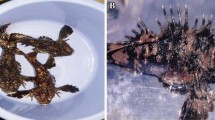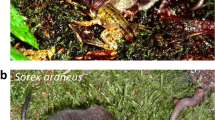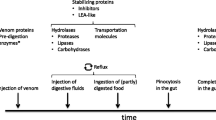Abstract
A potent proteinaceous chemoattractant, eliciting prey attack by checkered garter snakes (Thamnophis marcianus) was isolated from aqueous washes of the common frogRana temporaria and purified by preparative continuous-elution electrophoresis. The biological activity of the frog crude extract or of the purified chemoattractive protein, measured by a snake bioassay, was unaffected by freezing, lyophilization, or dialysis but was lost after proteolytic digestion. The purified chemoattractant is glycosylated, has an apparent molecular mass of 24 kDa, estimated by polyacrylamide gel electrophoresis in the presence of sodium dodecyl sulfate (SDS-PAGE), and a pI of 4.8. It gave one spot in two-dimensional electrophoresis. The bioassay showed that this protein is highly attractive to snakes. The lowest concentration yielding positive responses in the snake bioassay was approximately 25 µg/ml. These results suggest that a water-soluble Mr 24 kDa glycoprotein molecule produced by the common frog may be a vomeronasal stimulus used by checkered garter snakes for prey recognition.
Similar content being viewed by others
References
Bradford, M.M. 1976. A rapid and sensitive method for the quantitation of microgram quantities of protein utilizing the priniciple of protein-dye binding.Anal. Biochem. 72:248–254.
Burghardt, G.M. 1966. Stimulus control of the prey attack response in naive garter snakes.Psychon. Sci. 4:37–38.
Burghardt, G.M. 1970. Chemical perception in reptiles, pp. 241–308,in J.W. Johnston, Jr., D.G. Moulton, and A. Turk (eds.). Advances in Chemoreception. Appleton Century Crofts, New York.
Burghardt, G.M. 1980. Behavioral and stimulus correlates of vomeronasal functioning in reptiles: Feeding, grouping, sex, and tongue use, pp. 275–301,in D. Muller-Schwarze and R.M. Silverstein (eds.). Chemical Signals in Vertebrates and Aquatic Invertebrates. Plenum Press, New York.
Burghardt, G.M. 1990. Chemically mediated predation in vertebrates: diversity, ontogeny and information, pp. 475–499,in D. McDonald, D. Muller-Schwarze, and S. Natynczuk (eds.). Chemical Signals in Vertebrates, Vol. 5. Oxford University Press, Oxford.
Burghardt, G.M. 1992. Prior exposure to prey cues influences chemical prey preferences and prey choice in neonatal garter snakes.Anim. Behav. 44:787–789.
Burghardt, G.M. 1993. The comparative imperative—genetics and ontogeny of chemoreceptive prey responses in natricine snakes.Brain Behav. Evol. 41:138–146.
Burghardt, G.M., Goss, S.E., andSchell, F.M. 1988. Comparison of earthworm- and fish-derived chemicals eliciting prey attack by garter snakes (Thamnophis).J. Chem. Ecol. 14:855–881.
Cooper, W.E., Jr., andBurghardt, G.M. 1990. A comparative analysis of scoring methods for chemical discrimination of prey by squamate reptiles.J. Chem. Ecol. 16:45–65.
Conant, R. 1975. A Field Guide to Reptiles and Amphibians of Eastern and Central North America. Houghton Mifflin Company, Boston.
Deutscher, M.P. 1990. Guide to protein purification. Methods Enzymol. 182:425–441.
Drummond, H.M. 1979. Stimulus control of amphibious predation in the northern water snake (Nerodia sipedon sipedon).Z. Tierpsychol. 50:18–44.
Drummond, H. 1983. Aquatic foraging in garter snakes: A comparison of specialists and generalists.Behaviour 86:1–30.
Drummond, H. 1985. The role of vision in the predatory behaviour of natricines snakes.Anim. Behav. 33:206–215.
Graves, B.M. 1993. Chemical delivery to the vomeronasal organs and functional domain of squamate chemoreception.Brain Behav. Evol. 41:198–202.
Halpern, M. 1987. The organization and function of the vomeronasal system.Ann. Rev. Neurosci. 10:325–362.
Halpern, M., andFrumin, N. 1979. Roles of the vomeronasal and olfactory systems in prey attack and feeding in adult garter snakes.Physiol. Behav. 22:1183–1189.
Halpern, M., andKubie, J.L. 1980. Chemical access to the vomeronasal organs of garter snakes.Physiol. Behav. 24:367–371.
Halpern, M., Schulman, N., Scribani, L., andKirschenbaum, D.M. 1984. Characterization of vomeronasally-mediated response-eliciting components of earthworm wash-II.Pharmacol. Biochem. Behav. 21:655–662.
Henzel, W.J., Rodriguez, H., Singer, A.G., Stults, J.T., Macrides, F., Agosta, W.C., andNiall, H. 1988. The primary structure of aphrodisin.J. Biol. Chem. 263:16682–16687.
Inouchi, J., Wang, D., Jiang, X.C., Kubie, J., andHalpern, M. 1993. Electrophysiological analysis of the nasal chemical senses in garter snakes.Brain Behav. Evol. 41:171–182.
Jiang, X.C., Inouchi, J., Wang, D., andHalpern, M. 1990. Purification and characterization of a chemoattractant from electric shock-induced earthworm secretion, its receptor binding, and signal transduction through the vomeronasal system of garter snakes.J. Biol. Chem. 265:8736–8744.
Kahmann, H. 1932. Sinnesphysiologische Studien an Reptielen—I. Experimentalle Untersuchungen uber das Jacobsonische Organ der Eidechsen und Schlangen.Zool. Jb. Abt. Allg. Zool. Physiol. 51:173–238.
Kirschenbaum, D.M., Schulman, N., Yao, P., andHalpern, M. 1985. Chemo-attractant for the garter snake: Characterization of vomeronasally-mediated response-eliciting components of earthworm wash-III.Comp. Biochem. Physiol. 82B:447–453.
Kirschenbaum, D.M., Schulman, N., andHalpern, M. 1986. Earthworms produce a collagenlike substance detected by the garter snake vomeronasal system.Proc. Natl. Acad. Sci. U.S.A. 83:1213–1216.
Kubie, J.L., andHalpern, M. 1978. Garter snake trailing behavior: Effects of varying pre-extract concentration and mode of prey-extract presentation.J. Comp. Physiol. Psychol. 92:362–373.
Kubie, J.L., andHalpern, M. 1979. Chemical senses involved in garter snake prey trailing.J. Comp. Physiol. Psychol. 93:648–667.
Laemmli, U.K. 1970. Cleavage of structural proteins during the assembly of the head of bacteriophage T4.Nature 227:680–685.
Leach, B.S., Collawn, J.F., andFish, W.W. 1980. Behavior of glycopeptides with empirical molecular weight estimation methods. 1. In sodium dodecyl sulfate.Biochemistry 19:5734–5741.
Macrides, F., andSinger, A.G. 1991. A hamster macromolecular pheromone belongs to a family of transport and odorant binding proteins, pp. 169–185,in C.J. Wysocki, and M.R. Kare (eds.). Chemical Senses, Vol. 3. Genetics of Perception and Communication. Marcel Dekker, New York.
Mushinsky, H.R., andLotz, K.H. 1980. Chemoreceptive responses of two sympatric water snakes to extracts of commonly ingested prey species. Ontogenetic and ecological considerations.J. Chem. Ecol. 6:523–535.
O'Farrell, P.H. 1975. High resolution two-dimensional electrophoresis of proteins.J. Biol. Chem. 250:4007–4021.
Reformato, L.S., Kirschenbaum, D.M., andHalpern, M. 1983. Preliminary characterization of response-eliciting components of earthworm extract.Pharmacol. Biochem. Behav. 18:247–254.
Sheffield, L.P., Law, J.L., andBurghardt, G.M. 1968. On the nature of chemical food sign stimuli for newborn garter snakes.Commun. Behav. Biol. 2A:7–12.
Singer, A.G., Macrides, F., Clancy, A.N., andAgosta, W.C. 1986. Purification and analysis of a proteinaceous aphrodisiac pheromone from hamster vaginal discharge.J. Biol. Chem. 261:13323–13326.
Steward, J.W. 1971. The Snakes of Europe. David & Charles, Newton Abbot.
Teather, S.M. 1991. The relative importance of visual and chemical cues for foraging in newborn blue-striped garter snakesThamnophis sirtalis similis.Behaviour 117:255–261.
Wang, D., Chen, P., Jiang, X.C., andHalpern, M. 1988. Isolation from earthworms of a proteinaceous chemoattractant to garter snakes.Arch. Biochem. Biophys. 267:459–466.
Wang, D., Jiang, X.C., Chen, P., Inouchi, J., andHalpern, M. 1993. Chemical and immunological analysis of prey-derived vomeronasal stimulants.Brain Behav. Evol. 41:246–254.
Wright, A.H., andWright, A.A. 1970. Handbook of Snakes of the United States and Canada. Comstock Publishing Associates, Ithaca, New York.
Author information
Authors and Affiliations
Rights and permissions
About this article
Cite this article
Wattiez, R., Remy, C., Falmagne, P. et al. Purification and preliminary characterization of a frog-derived proteinaceous chemoattractant eliciting prey attack by checkered garter snakes (Thamnophis marcianus). J Chem Ecol 20, 1143–1160 (1994). https://doi.org/10.1007/BF02059750
Received:
Accepted:
Issue Date:
DOI: https://doi.org/10.1007/BF02059750




